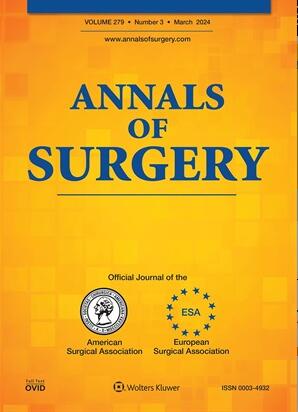Informing Decision-making for Transected Margin Reresection in Intraductal Papillary Mucinous Neoplasm-derived PDAC: An International Multicenter Study.
IF 7.5
1区 医学
Q1 SURGERY
引用次数: 0
Abstract
OBJECTIVE To assess the prognostic impact of margin status in patients with resected intraductal papillary mucinous neoplasms (IPMN)-derived pancreatic ductal adenocarcinoma (PDAC) and to inform future intraoperative decision-making on handling differing degrees of dysplasia on frozen section. SUMMARY BACKGROUND DATA The ideal oncologic surgical outcome is a negative transection margin with normal pancreatic epithelium left behind. However, the prognostic significance of reresecting certain degrees of dysplasia or invasive cancer at the pancreatic neck margin during pancreatectomy for IPMN-derived PDAC is debatable. METHODS Consecutive patients with resected and histologically confirmed IPMN-derived PDAC (2002-2022) from six international high-volume centers were included. The prognostic relevance of a positive resection margin (R1) and degrees of dysplasia at the pancreatic neck margin were assessed by log-rank test and multivariable Cox-regression for overall survival (OS) and recurrence-free survival (RFS). RESULTS Overall, 832 patients with IPMN-derived PDAC were included with 322 patients (39%) having an R1-resection on final pathology. Median OS (mOS) was significantly longer in patients with an R0 status compared to those with an R1 status (65.8 vs. 26.3 mo P<0.001). Patients without dysplasia at the pancreatic neck margin had similar OS compared to those with low-grade dysplasia (mOS: 78.8 vs. 66.8 months, P=0.344). However, high-grade dysplasia (mOS: 26.1 mo, P=0.001) and invasive cancer (mOS: 25.0 mo, P<0.001) were associated with significantly worse OS compared to no or low-grade dysplasia. Patients who underwent conversion of high-risk margins (high-grade or invasive cancer) to a low-risk margin (low-grade or no dysplasia) after intraoperative frozen section had significantly superior OS compared to those with a high-risk neck margin on final pathology (mOS: 76.9 vs. 26.1 mo P<0.001). CONCLUSIONS In IPMN-derived PDAC, normal epithelium or low-grade dysplasia at the neck have similar outcomes while pancreatic neck margins with high-grade dysplasia or invasive cancer are associated with poorer outcomes. Conversion of a high-risk to low-risk margin after intraoperative frozen section is associated with survival benefit and should be performed when feasible.导管内乳头状黏液瘤源性 PDAC 切缘切除的决策依据:一项国际多中心研究。
目的评估边缘状态对切除导管内乳头状粘液瘤 (IPMN) 衍生胰腺导管腺癌 (PDAC) 患者预后的影响,并为今后处理冰冻切片上不同程度发育不良的术中决策提供参考。方法纳入了来自 6 个国际高容量中心切除并经组织学证实为 IPMN 衍生型 PDAC 的连续患者(2002-2022 年)。结果共纳入 832 例 IPMN 衍生型 PDAC 患者,其中 322 例患者(39%)的最终病理结果为 R1-切除。R0患者的中位OS(mOS)明显长于R1患者(65.8月 vs. 26.3月,P<0.001)。胰腺颈部边缘无发育不良的患者与低度发育不良的患者的OS相似(mOS:78.8个月 vs. 66.8个月,P=0.344)。然而,与没有或低度发育不良的患者相比,高级别发育不良(mOS:26.1个月,P=0.001)和浸润性癌(mOS:25.0个月,P<0.001)与明显较差的OS相关。术中冰冻切片后将高风险切缘(高级别或浸润性癌)转化为低风险切缘(低级别或无发育不良)的患者与最终病理结果为高风险颈部切缘的患者相比,其 OS 明显更优(mOS:76.结论 在源自 IPMN 的 PDAC 中,颈部正常上皮或低度发育不良的患者具有相似的预后,而胰腺颈部边缘有高级别发育不良或浸润性癌的患者预后较差。术中冰冻切片后将高风险边缘转为低风险边缘与生存获益相关,因此在可行的情况下应进行这种转换。
本文章由计算机程序翻译,如有差异,请以英文原文为准。
求助全文
约1分钟内获得全文
求助全文
来源期刊

Annals of surgery
医学-外科
CiteScore
14.40
自引率
4.40%
发文量
687
审稿时长
4 months
期刊介绍:
The Annals of Surgery is a renowned surgery journal, recognized globally for its extensive scholarly references. It serves as a valuable resource for the international medical community by disseminating knowledge regarding important developments in surgical science and practice. Surgeons regularly turn to the Annals of Surgery to stay updated on innovative practices and techniques. The journal also offers special editorial features such as "Advances in Surgical Technique," offering timely coverage of ongoing clinical issues. Additionally, the journal publishes monthly review articles that address the latest concerns in surgical practice.
 求助内容:
求助内容: 应助结果提醒方式:
应助结果提醒方式:


